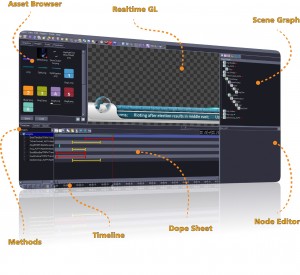SVG Europe Sit-Down: RT Software’s Luke Harrison on graphics evolution and the integration impulse
There can be few areas of production technology that have seen greater innovation in recent years than on-screen graphics – and that is even more apparent when it comes to sports graphics in particular. As Luke Harrison, technical product marketing manager of RT Software, points out, sports graphics have evolved to become a huge market sector. With many channels now dedicated to sports, it follows that graphics are crucial to the live game content, studio analysis and channel branding. That evolution is an obvious place to start our conversation…
Graphics have come a long, long way since simply captioning a broadcast. Is there one innovation that stands out in your mind as the bottom line of innovation?
The obvious one is the ability to real-time render graphics in a 3D space. This means a lot more than just being able to give depth to graphics, it also allows tighter integration of graphics into the production, either in a completely virtual environment, or a real environment as augmented reality graphics.
Then there is data integration, where the graphic is showing much more information than just a name caption or score. The amount of data available now allows graphics to show the viewer a level of detail of what is happening whilst the event is taking place that was previously impossible. Motorsport viewers see this in the form of engine telemetrics, football viewers in the form of heat-maps or player stats, all in real time, which helps to tell the viewer a much more engaging story.
What do you see as the biggest challenges you face today?
Getting the most out of commercially available workstations in terms of rendering power. Customers are looking at ways to render more photorealistic graphics on low cost kit, so high quality rendering is not the be all and end all, it must also be resource efficient by using techniques such as Physical Based Rendering.
Also, integration to third party applications and devices, graphics are no longer an Island. Broadcasters expect their graphics systems to integrate fully to their workflow in terms of control, asset sharing and rundown creation. So, we need to be accessible to users of NRCS, video editing, and playout systems for example.
Programme directors and producers have become more specialised in their craft. Do the same deeper insights into sports apply to graphics operators, too?
Absolutely, when I worked as a graphics op back in the 90s, you worked on whatever programme was taking place during your shift, regardless of the sport. This goes back to the first question, in those days the requirements were the same across all sports, you were just putting up captions. Now graphics are expected to tell a story and give in depth analysis, so familiarity with the sport you are working on is essential. As a result, broadcasters definitely prefer to use graphics ops which have a specialisation within the sport they are broadcasting.
Everyone is seeking to reduce costs. How can this be achieved with regards to the broadcast graphics environment?
We’ve seen hardware costs reduce and also the size of kit – if needed, we can go to air from laptops today which was unthinkable a few years ago. We know that many broadcasters look at the cost per “u” and focus hard on reducing that. One of the ways we contribute positively to that is through the virtualisation of our graphics, enabling a single PC to host many independent channels of graphics.
Plus “sweating assets” is a phrase we come across at the larger broadcasters. They love the fact that playout graphics assets can now be used live in a sporting event or studio show. This is possible with our embedded OEM graphics as they have an asynchronous control option combined with a distributable, flexible web based manual control option. Partners such as SAM who embed our graphics in their “Channel in a box” solution are now successfully deploying this with major broadcasters.
Does the growth of second screens affect your work for broadcast applications?
Absolutely, this has driven the need for more sophisticated sports data across both areas, and thus centralised data and data sharing. Plus, of course, second screening can invite live fan contributions, tweets and the like. We have to make sure that sitting across our graphics solutions are workflow tools that allow the accessing of shared data and also repurposing of graphics for multiple formats.
What will the growth of 4K (or higher) mean to you?
We are seeing see the emergence of clear standards for 4K and HDR as something being worked on right now – and crucial to establish clarity and confidence in the new technologies. One thing to bear in mind is that 4K does not just mean more pixels – without taking advantage of HDR, you are not really full 4K, which means that 8-bit colour is no longer enough. We knew this when we implemented 4K so went to 10-bit colour, and I think we were one of the first graphic vendors to do so. But we didn’t stop there, we also implemented floating point rendering so are ready to embrace HDR, 8K, 16K – wherever the emerging standards of our industry takes us.
At BVE you said that the game is changing. What do you see being the real game changers in the next 12 months?
As far playout is concerned, we see a demand for easily distributed control where control of the live graphics output is no longer constrained to one directly connected device. Our Web Control solution allows control of any live renderer or multiple renders through a Chrome Web browser, so it can be done from any device on the facility network. This has huge implications for flexibility of playout and, of course, redundancy. If the production needs to switch studio, gallery or both at the last minute, as far as the graphic operator is concerned, they just log in at their new location and they have the same control application as they would have before.
Video over IP is definitely coming as it has so many advantages for the broadcast facility – not just in ease of routing. With current uncertainty over emerging 4K and HDR formats, a facility using an IP based infrastructure knows that wherever the industry goes in terms of formats, it will be ready.
We are also seeing a lot of interest from broadcasters in ways to reduce the amount of physical rack space required in the machine room, not just for maintenance reasons, but also for cost. After all, rack space is expensive. As GPU power increased, this allows us to deploy “virtualisation” – where one workstation is rendering multiple channels of graphics. This is further enabled by IP based distribution as you are no longer limited to how many video SDI outputs you can squeeze into a workstation. And, of course, the move to web based control means each virtual channel can be controlled in the same way as a physical machine. At IBC and NAB last year we were outputting eight graphic channels from one 3U workstation each channel controlled over the web and being distributed over IP using the NewTek NDI, one of the many IP formats we support. This has moved from demonstration to deployment with a major broadcaster about to go live with over 100 channels using our virtualised graphics.



